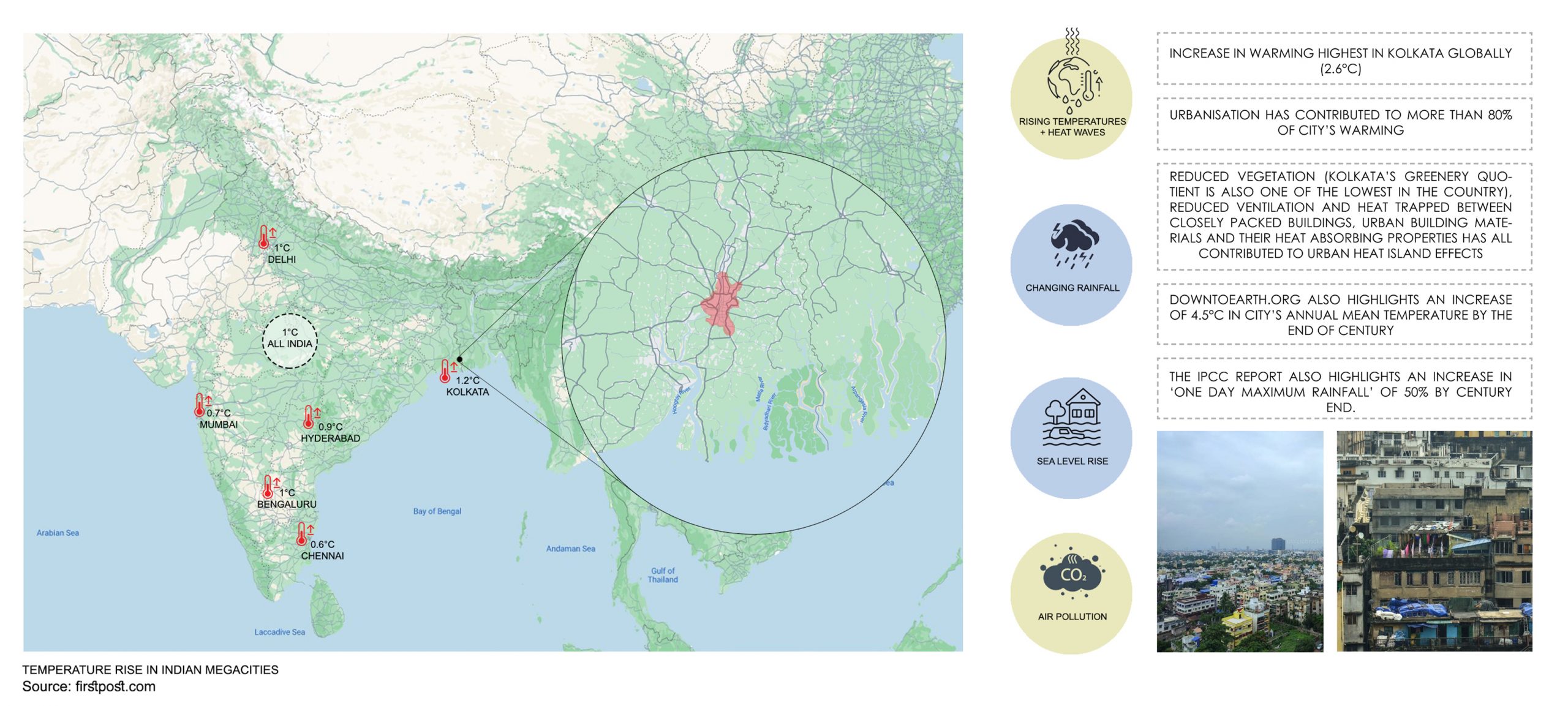Kolkata, India
Reshaping Kolkata’s Green Spaces: Architect Gursharan Randhawa’s Vision for Comfort in Urban Planning
Addressing Urbanization, Climate Challenges, and Future Adaptation
Discover why Kolkata, India, is one of the cities most vulnerable to climate change effects. Factors such as its unique geographical location, high population density, and socio-economic issues, including widespread poverty, make Kolkata a climate risk hotspot. The 6th Assessment Report of the IPCC confirms Kolkata’s dual climate challenges: rising heat and humidity and more frequent cyclones.
Witness how climate change is visibly impacting Kolkata, with more extreme weather, increasing temperatures, and deteriorating air quality. Nestled in the Ganges Delta, the city is critically vulnerable to sea-level changes. Forecasts predict a potential sea-level rise of up to 1.5 meters by 2100.
Experience the growing intensity and frequency of Kolkata’s heatwaves, with summer temperatures peaking at 45 degrees Celsius. Such heat exacerbates health risks and leads to shortages of water, power, and food.
Learn about Kolkata’s worsening air quality due to heightened emissions from vehicles, industries, and biomass burning. Understand the resulting health implications, including respiratory and cardiovascular diseases.
Our study approach begins with a thorough review of both modern and traditional urban design literature. Kolkata’s history categorizes the city’s urban context into three distinct periods: the Old city Calcutta, the Colonial Era as the British capital, and the transformation from Calcutta to a megacity, Kolkata.
Next, we examine Kolkata’s urbanization pattern for context comprehension. The research spotlights two Kolkata neighborhoods—one from the old city and one from the new planned municipality. We scrutinize their green pockets and parks, assessing thermal comfort parameters. Taking into account local climatic conditions, all simulations were conducted for May 21, the peak of summer heat stress—a grave concern highlighted by the IPCC.

Successful Thermal Comfort Strategies in Kolkata’s Urban Landscape
In its tropical setting, Kolkata grapples with year-round high temperatures, often climbing to 45°C in summer with a heat index of 50°C. This intense heat triggers health issues like heat stroke, exhaustion, and dehydration, posing potentially life-threatening risks if left unmanaged. A closer look at the neighborhoods of Howrah and Salt Lake offers insights into the city’s current climatic and living conditions and potential heat stress mitigation strategies.
Kolkata is strained under the combined effects of extreme temperature-related heat stress and high humidity. This study breaks down these elements to showcase the benefits of nature-based solutions. Physiologically Equivalent Temperature (PET) is used as an indicator of heat stress, demonstrating that the planned Salt Lake neighborhood copes better than the densely populated old town of Howrah.
Nature-based solutions can mitigate the heat stress levels in the Salt Lake neighborhoods from strong to moderate during direct sun hours, reducing temperatures by 4-6 °C through optimized use of open spaces and wind direction. Conversely, in the crowded Howrah neighborhood, introducing urban green pockets in open hardscaped spaces reduces the PET by 2-4°C, though heat stress remains high.
A hypothetical scenario for Salt Lake, with evenly distributed green parks and pockets, suggests an even greater potential for temperature reduction, up to 8°C in extreme heat conditions.
Old compact settlements are humidity hotspots and require strategies such as air movement through mechanical means or water-absorbing facades to improve microclimatic conditions. These interventions could further reduce moderate heat stress to mild or neutral temperature ranges.
The accompanying image encapsulates the efforts to enhance neighborhood comfort, reimagining green spaces and parks for a more sustainable microclimate.



Reimagining Kolkata: Architectural Solutions for Thermal Comfort
